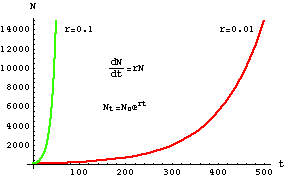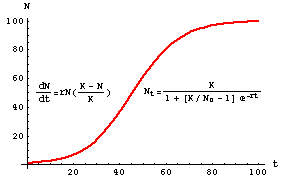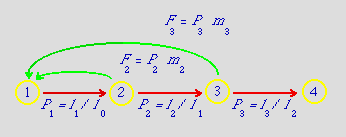Lecture notes for ZOO 4400/5400 Population Ecology
Lecture 1 (14-Jan-13
Monday) The stuff of population ecology
Required reading #1: Gotelli: To the student (at beginning of text) – in the WyoWeb "required readings" folder
Return to Main Index page
Go forward to notes for Lecture 2, 14-Jan
Welcome to the course (syllabus, format, web and e-mail resources).
A tip for studying. Read over the web notes before each lecture,
then again after the lecture. I will post all Powerpoints that I used in class to WyoWeb, usually at least a week ahead. I may occasionally give in-class quizzes (one or two points)
just to check that people have read the notes -- they won't be hard questions, just a check on whether you have
prepared by glancing ahead at what's to come.
The stuff of population ecology:
1) What determines the distribution and abundance of populations?
2) What processes regulate populations --
i.e., why don't populations grow exponentially forever?
What are some of the major kinds of interactions and processes we will explore?
(This is a rough outline of the shape of the lectures, though I may substantially alter some portions).
Single-population growth models:
Exponential growth (the baseline against which to assess alternatives)

Fig. 1.1. Exponential growth of a population (N) as a function of time (t).
Logistic growth (adding density dependence)

Fig. 1.2. Logistic growth of a population (N) over time (t).
Continuous vs. discrete time
Do human populations obey dampened logistic growth or undamped exponential growth?
(all the items in red italic font will be examples of case histories from
real-world populations or lab. experiments)
What is a population? Limits, processes and characteristics.
Assessing abundance -- indices vs. estimates of absolute density
Demography -- births, deaths, life tables, sex ratios
Density, status and sex ratio in elk
A special form of demography -- matrix-based approaches
Age- or stage-structured population growth
Growth rates
(r and l)
Stable stage distribution
Reproductive value
Sensitivity and elasticity analyses
Changes
in what part of the Sage Grouse life cycle will have the greatest impact on population growth?
When one
whale matters -- Right whale case history [Fujiwara and Caswell required reading]

Fig. 1.3. A life cycle diagram from which a matrix analysis can be conducted.
Given information on vital rates (age- or stage-specific birth and survival rates),
one can calculate many important population parameters such such as growth rates,
reproductive values and the sensitivity of the growth rate to changes in a vital rate.
Intraspecific competition -- scramble, contest, stability analysis, chaos
Experimental tests of competition and chaos
Tribolium flour beetles show experimentally induced chaotic fluctuations
Starfish
predators promote coexistence of competing prey
Interspecific competition -- paired logistic equations, coexistence
Limiting similarity, character displacement, character release
Predator/prey, herbivory and host/parasite interactions
Lotka-Volterra and graphical models with greater realism
Population cycles
Experimental
parasite control damps cycles in red grouse [Hudson et al. required reading]
Experimental
predator removal damps vole cycles
[Korpimaki et al. required reading]
Harvest and yield
Host-parasite models
Are lemmings and voles predators or prey?
[Turchin et al. required reading]
Can predators be the "straw that breaks the camel's back" for local extinctions?
Population regulation
Density-dependence vs. density-independence (Andrewartha and Birch vs. Lack)
Limiting factors: habitat, space, food resources, disease
Top-down and bottom-up regulation
How can
tree rings tell us how wolves regulate moose populations?
[McLaren
and Peterson, suggested reading]
Disease as a population regulator
How deer, caribou, moose regulation was driven by a parasitic nematode
Do populations respond immediately or with lags?
Response to immediate not past environments in voles
Lagged
response to ocean changes in long-lived seabirds
Human ecology: how dense can we get? 6 billion and counting......
Ireland vs. Iceland -- it's not just family size that counts...
End of Lecture 1, 14-Jan-13
§§§§
§§§§§§§§§§§§§§§
§§§§§§§§§§§§§§§§§
§§§§§§§§§§§§§§§
§§§
§§§§§§§§§§§§§§§
§§§§§§§§§§
Return to top of page
Go forward to notes for Lecture 2, 16-Jan


